Paintings in Parliament House
Paintings in Parliament House
Paintings in Parliament House
You also want an ePaper? Increase the reach of your titles
YUMPU automatically turns print PDFs into web optimized ePapers that Google loves.
<strong>Pa<strong>in</strong>t<strong>in</strong>gs</strong><br />
In <strong>Parliament</strong> <strong>House</strong><br />
As one enters the <strong>Parliament</strong> <strong>House</strong>, one is<br />
fasc<strong>in</strong>ated by a row of beautiful pa<strong>in</strong>t<strong>in</strong>gs<br />
adorn<strong>in</strong>g the walls of the outer circular corridor<br />
on the ground floor. The pa<strong>in</strong>t<strong>in</strong>gs are the works<br />
of em<strong>in</strong>ent artists of India, depict<strong>in</strong>g scenes from<br />
the long history of this country right from the<br />
Vedic age down the British period, culm<strong>in</strong>at<strong>in</strong>g<br />
<strong>in</strong> the atta<strong>in</strong>ment of <strong>in</strong>dependence <strong>in</strong> 1947.<br />
The practice <strong>in</strong> India of decorat<strong>in</strong>g public places,<br />
temples and palaces etc., with pa<strong>in</strong>t<strong>in</strong>gs and<br />
murals has come down to us s<strong>in</strong>ce time<br />
immemorial. These pieces of art are symbolic<br />
of the life, culture and traditions of the people of<br />
the contemporaneous periods. To us now, they are<br />
rem<strong>in</strong>iscent of the great civilizations and empires<br />
that flourished <strong>in</strong> India <strong>in</strong> the past and of the<br />
great k<strong>in</strong>gs, warriors and sa<strong>in</strong>ts who by their<br />
efforts glorified this land of ours. The caves of<br />
Ajanta, Ellora and Elephanta are vivid rem<strong>in</strong>ders of<br />
great art that flourished centuries ago.<br />
It was natural, therefore, that the architects of<br />
modern India should have thought it fit to<br />
decorate the modern temple of democracy, i.e.<br />
the <strong>Parliament</strong> <strong>House</strong>, with pa<strong>in</strong>t<strong>in</strong>gs depict<strong>in</strong>g<br />
great moments <strong>in</strong> the history of this country<br />
and to try to revive <strong>in</strong> some measure the glory<br />
that was 'India'. The idea was first conceived<br />
by the late Shri G.V. Mavalankar, the first<br />
Speaker of Lok Sabha. In 1951, a Plann<strong>in</strong>g<br />
Committee was appo<strong>in</strong>ted, consist<strong>in</strong>g of<br />
prom<strong>in</strong>ent Members of <strong>Parliament</strong>, em<strong>in</strong>ent<br />
scholars, archaeologists, historians with the<br />
Speaker (Shri G.V. Mavalankar) as Chairman. The<br />
Committee drew up a detailed plan to decorate<br />
the corridor on the ground floor of the<br />
<strong>Parliament</strong> <strong>House</strong> with 125 panels (size 11'.9" x<br />
4'.11/2'') and 46 motifs, at an estimated cost of<br />
Rs. 3 lakhs. Accord<strong>in</strong>g to revised plan the<br />
corridor on Ground Floor of the <strong>Parliament</strong> <strong>House</strong><br />
will be decorated with 59 Panels.<br />
In order to execute the plan, an Artists Sub-<br />
Committee consist<strong>in</strong>g of well-known artists,<br />
historians, archaeologists and archaeological<br />
chemists was appo<strong>in</strong>ted <strong>in</strong> 1954. This<br />
Sub-Committee laid down a detailed and<br />
systematic procedure for gett<strong>in</strong>g the panels<br />
pa<strong>in</strong>ted by selected artists <strong>in</strong> the country.<br />
So far, 58 panels have been completed and<br />
displayed <strong>in</strong> the outer corridor on the ground
floor of the <strong>Parliament</strong> <strong>House</strong>. A brief description<br />
of the panels already on display is given below: —<br />
Panel No. 1<br />
The seal of Shiva as Yogi show<strong>in</strong>g the Indian<br />
ideal of meditation. Also Bull and Unicom. From<br />
Mohenjodaro (3rd Millennium B.C.).<br />
Artist - Shri H.V. Ram Gopal, Chennai.<br />
Artist Supervisor — Shri K.C.S. Paniker, Chennai.<br />
Panel No. 2<br />
Metal image of danc<strong>in</strong>g girl and stone carv<strong>in</strong>g of<br />
priest. From Mohenjodaro (3rd Millennium B.C.)<br />
Artist - Shri Rama Krishna Rao, Chennai. Artist<br />
Supervisor — Shri K.C.S. Paniker, Chennai.<br />
Panel No. 3<br />
This panel illustrates two scenes from the epic<br />
Ramayana. The first one depicts the compassion<br />
of Valmiki with the quotation "ma nishada" etc.<br />
The other depicts the meet<strong>in</strong>g of Rama and<br />
Guha (K<strong>in</strong>g of Nishadas), symbolis<strong>in</strong>g the meet<strong>in</strong>g<br />
of the Aryan and Austric cultures.<br />
Artist — Shri K. Sreenivasulu, Chennai.<br />
Artist Supervisor— Shri K.C.S. Paniker, Chennai.<br />
Panel No. 4<br />
Scene depict<strong>in</strong>g the establishment of Rama<br />
Rajya. The pr<strong>in</strong>cipal figures shown are Rama,<br />
Sugriva, Hanuman, Vasishtha, Lakshmana, Sita,<br />
Bharata, Shatrughna and the three mothers<br />
Kaushalya, Kaikeyi and Sumitra.<br />
Artist— Shri P.L. Narasimha Murthy, Chennai.<br />
Artist Supervisor- Shri K.C.S. Paniker, Chennai.<br />
Panel No. 5<br />
(a) Rishi Krishna Dvaipayana, the author of the<br />
Mahabharata, with the quotation about<br />
the<br />
greatness of Dharma (law, piety and truth)—<br />
"namo dharmaya mahate dharmo dharayoti<br />
prajah".<br />
(b) Manu, the first law giver.<br />
Artist and Artist Supervisor — Shri K.C.S.<br />
Paniker, Chennai.
Panel No. 6<br />
Scene from the f irst Congress of Indian<br />
philosophers convened by Janaka - Janaka and<br />
Yajnavalkya, show<strong>in</strong>g also Maitreyi, Gargi,<br />
Saulbha and Ashtavakra.<br />
Artist — Shri S. Dhanapal, Chennai.<br />
Artist Supervisor - Shri K.C.S. Paniker, Chennai.<br />
Panel No. 7<br />
Mahavira (6th Century B.C.) with Ad<strong>in</strong>atha and<br />
Parsvanatha on either side, all seated with<br />
appropriate symbols. The statue of Gomateswara<br />
at Sravanabelgola is also shown.<br />
Artist - Shri A. Balakrishnan, Chennai.<br />
Artist Supervisor — Shri K.C.S. Paniker, Chennai.<br />
Panel No. 8<br />
Buddha's temptation show<strong>in</strong>g Buddha seated on<br />
Vajrasana with Mara and his host on one side<br />
and his daughters on the other (6th Century<br />
B.C.).<br />
Artist - Shri S. Sen Roy, New Delhi. Artist<br />
Supervisor — Shri Barada Ukil, Delhi.<br />
Panel No. 9<br />
Buddha turn<strong>in</strong>g the wheel of law (Dharma-Chakra<br />
Pravartana). It also shows the first five disciples<br />
of the Buddha at Sarnath and the symbol show<strong>in</strong>g<br />
the Dharma Chakra with two couchant stags on<br />
either side.<br />
Artist - Shri Sushil Sarkar, Chandigarh.<br />
Artist Supervisor - Shri Barada Ukil, Delhi.<br />
Panel No. 11<br />
Scene represent<strong>in</strong>g the meet<strong>in</strong>g of the elders of<br />
the Lichchhavi clan, show<strong>in</strong>g the co<strong>in</strong>s of the<br />
earlier Ganas such as Andhakas, Vrishnis,<br />
Yaudheyas, Malavas, etc.<br />
Artist Supervisor— Shri Barada Ukil, Delhi.<br />
Panel No. 12<br />
Pan<strong>in</strong>i (500 B.C. B.C.).<br />
and Chanakya (4th Century<br />
Artist — ShriPratap Chandra Sen, New Delhi.<br />
Artist Supervisor - Shri Barada Ukil, Delhi.
Panel No. 13<br />
Alexander and Paurava, K<strong>in</strong>g Paurava (Porus)<br />
before Alexander as prisoner (4th Century B.C.).<br />
Artist - Shri S. Sen Roy, New Delhi.<br />
Artist Supervisor - Shri O.P. Sharma, New Delhi.<br />
Panel No. 14<br />
(a) Asoka send<strong>in</strong>g out missions to<br />
different countries. Asoka, monks and the<br />
Greek K<strong>in</strong>gs (3rd Century B.C.)<br />
(b) Asoka's Buddhist Council.<br />
Artist - Shri B.N. Jijja, Delhi.<br />
Artist Supervisor - Shri Barada Ukil, Delhi.<br />
Panel No. 15<br />
Deputation of Mahendra and Sanghamitra with<br />
the Bodhi tree to Ceylon-from the scene <strong>in</strong><br />
Cave-1 at Ajanta (3rd Century B.C.).<br />
Artist — Shri Amulya Gopal Sen Sarma, Kolkata.<br />
Artist Supervisor - Shri S. N. Ghosal, Kolkata.<br />
Panel No. 16<br />
K<strong>in</strong>g Menander <strong>in</strong> discussion with a Buddhist<br />
monk, Nagasena. Quotation from Mil<strong>in</strong>da Panho<br />
(2nd Century B.C.) and a co<strong>in</strong> of Menander.<br />
Artist — Shri Amulya Gopal Sen Sarma, Kolkata.<br />
Artist Supervisor - Shri S.N. Ghosal, Kolkata.<br />
Panel No. 17<br />
Pushyamitra Sunga and PatanjaLi—his Yajna with<br />
Patanjali as the officiat<strong>in</strong>g Priest (2nd Century<br />
B.C.) Horse, Yua, K<strong>in</strong>g and a congregation of<br />
Priests are also shown.<br />
Artist - Shri Dhirendra Nath Brahma, Kolkata.<br />
Artist Supervisor - Shri S.N. Ghosal, Kolkata.<br />
Panel No. 18<br />
Heliodorus with his pillar <strong>in</strong> the background <strong>in</strong> a<br />
court scene. Heliodorus as an ambassador <strong>in</strong><br />
the court of K<strong>in</strong>g Bhaagabhadra of Vidisa and a<br />
quotation from the epigraph (2nd Century B.C.).<br />
Artist - Shri-Dhirendra Nath Brahma, Kolkata.<br />
Artist Supervisor - Shri S.N. Ghosal, Kolkata.
Panel No. 19<br />
K<strong>in</strong>g Mahameghavahana - Kharavela of Kal<strong>in</strong>ga and<br />
his Ja<strong>in</strong>a Council held at Udayagiri <strong>in</strong> the 13th year<br />
of his reign (2nd Century B.C.).<br />
Artist - Shri Sushil Chandra Sen, Uttarpara, District<br />
Hooghly.<br />
Artist Supervisor- Shri S.N. Ghosal, Kolkata.<br />
Panel No. 20<br />
Kanishka's Buddhist Council (1st Century A.D.)<br />
- the age of the m<strong>in</strong>gl<strong>in</strong>g of different cultures<br />
Zoroastrian, Buddhist and Brahmanical. Also<br />
show<strong>in</strong>g Kanishka's casket and different co<strong>in</strong><br />
types illustrat<strong>in</strong>g H<strong>in</strong>du, Buddhist and Zoroastrian<br />
div<strong>in</strong>ities.<br />
Artist - Shri Indra Dugar, Kolkata.<br />
Artist Supervisor — Shri S.N. Ghosal, Kolkata.<br />
Panel No. 21<br />
Early Buddhist Philosophers-<br />
Asvaghosha - 1st Century A.D.<br />
Nagarjuna - 2nd Century A.D.<br />
Vasubandhu - 4th Century A.D. D<strong>in</strong><br />
Naga - 5th Century A.D.<br />
Artist — Shri Indra Dugar, Kolkata.<br />
Artist Supervisor - Shri S.N. Ghosal, Kolkata.<br />
Panel No. 22<br />
"Charak and Susruta"<br />
Artist - Suhas Roy, Kolkata.<br />
Panel No. 23<br />
Rudradaman and Gautamiputra Satakarni<br />
(2nd Century A.D.).<br />
Artist — Shri Sayeed B<strong>in</strong> Mohammad, Hyderabad.<br />
Artist Supervisor — Shri Biswanath Mukerji, Delhi.<br />
Panel No. 25<br />
Chandragupta, Vikramaditya and Kalidasa, with a<br />
quotation- "A prosperous State is heaven on earth"<br />
-(riddhom hi rajyam padama<strong>in</strong>dram ahuh)—<br />
Raghuvamsa (Canto II, verse 50), Kalidasa<br />
read<strong>in</strong>g a manuscript of his work of Raghuvamsa<br />
to the K<strong>in</strong>g surrounded by Courtiers and officers<br />
(4th Century A.D.).
Artist — Shri S.D. Chawda, Mumbai.<br />
Artist Supervisor - Shri Gopal D. Deuskar,<br />
Mumbai.<br />
Panel No. 27<br />
Map to show trade relations with other countries<br />
such as Indian ivory from Begram and Pompeii<br />
and Mohenjodaro seats found <strong>in</strong> Mesopotamia<br />
and similar other f<strong>in</strong>d<strong>in</strong>gs.<br />
Reproduced map made <strong>in</strong> connection with the<br />
Inter-Asian Exhibition held <strong>in</strong> 1947 show<strong>in</strong>g<br />
India's contact with other Asiatic countries.<br />
Artist — Shri Vishnudas Ramdas, Mysore.<br />
Artist Supervisor - Shri Biswanath Mukerji,<br />
Delhi.<br />
Panel No. 28<br />
(a) Land<strong>in</strong>g of Indian naval merchants <strong>in</strong> Java.<br />
(b) Kaund<strong>in</strong>ya's arrival <strong>in</strong> Fu-nan.<br />
Artist — Shri Jagdish Mittal, Hyderabad.<br />
Artist Supervisor - Shri Biswanath Mukerji,<br />
Delhi.<br />
Panel No. 29<br />
Indian Scholars <strong>in</strong> Ch<strong>in</strong>a-Kasyapa Matanga<br />
(1st Century A.D.); Kumarajiva (A.D. 383-412);<br />
Dharmaraksha (5th Century A.D.).<br />
Artist - Shri V<strong>in</strong>od Shah and Shri V<strong>in</strong>odray Patel,<br />
Baroda.<br />
Artist Supervisor - Shri N.S. Bendre, Baroda.<br />
Panel No. 30<br />
Visit of Pr<strong>in</strong>ce Gunavaraman of Kashmir to East<br />
Indies and South Ch<strong>in</strong>a (5th Century A.D.).<br />
Artist - Miss Kumud Patel, Baroda.<br />
Artist Supervisor - Shri N.S. Bendre, Baroda.<br />
Panel No. 31<br />
Harshavardhana receiv<strong>in</strong>g the Ch<strong>in</strong>ese Pilgrim<br />
Hieun Tsang with an <strong>in</strong>set of the seal of the<br />
Nalanda University (7th Century A.D.).<br />
Artist - Shri Feroz N. Katpitia, Baroda. Artist<br />
Supervisor - Shri N.S. Bendre, Baroda.
Panel No.32<br />
Arya Bhatta {5th Century A.D.) and Varahamihira<br />
(7th Century A.D.).<br />
Artist - Miss Kumud Patel, Baroda.<br />
Artist Supervisor - Shri N.S. Bendre, Baroda.<br />
Panel No. 33<br />
The supposed Court scene of K<strong>in</strong>g Pulakes<strong>in</strong><br />
receiv<strong>in</strong>g presents from Khusro Parvez of Iran<br />
(7th Century A.D.) — from Cave 1 at Ajanta.<br />
Artist - Miss Kumud Patel, Baroda.<br />
Artist Supervisor - Shri N.S. Bendre, Baroda.<br />
Panel No. 34<br />
The descent of Ganga and the Penance of<br />
Bhagiratha at Mahabalipuram alongwith the<br />
portraits of Shimhavishnu and his wives as motif -<br />
7th Century A.D. (A.H. Longhurst Pallava<br />
Architecture).<br />
Artist — Shri S. Sen Roy, New Delhi Panel No. 35<br />
Gopala elected K<strong>in</strong>g by the People (9th Century<br />
A.D.).<br />
Artist — Shri V.P. Trivedi, Baroda.<br />
Artist Supervisor - Shri N.S. Bendre, Baroda.<br />
Panel No. 36<br />
Visit to Tibet of Santarakshita of Nalanda<br />
(8th Century A.D.), Padmasambhava of Udyana<br />
(8th Century A.D.), Srijnana Dipankara Atisa of<br />
Vikramasila (980 A.D.) and Kamalasila.<br />
Artist — Shri J.M. Ahivasi, Banaras.<br />
Artist Supervisor - Shri V.P. Karmarkar, Bombay.<br />
Panel No. 37<br />
Rajendra Chola and his naval expedition to<br />
Ceylon, Nicobar, Kadara and further cast to<br />
overcome the Sailendra empire (11th Century<br />
A.D.).<br />
Artist - Shri K.K. Hebbar, Bombay.<br />
. Artist Supervisor — Shri Gopal D. Deuskar,<br />
Bombay.
Panel No. 38<br />
Shankaracharya & Ramanujacharya. Artist - Shri<br />
B.N. Jijja, Delhi.<br />
Panel No. 41<br />
Paramara Bhoja with Bhojasala (Kamal Maula<br />
Mosque) <strong>in</strong> the background (12th Century A.D.).<br />
Artist — Shri G.M. Solegaonkar, Bombay. Artist<br />
Supervisor - Shri V.P. Karmarkar, Bombay.<br />
Panel No. 42<br />
Ferozeshah Tughlak with Kotla Ferozeshah,<br />
show<strong>in</strong>g Asoka column <strong>in</strong> the background<br />
(14th Century A.D).<br />
Artist - Shri Y.K. Shukla, Banasthali Vidyapeeth,<br />
Rajasthan.<br />
Artist Supervisor - Shri Gopal D. Deuskar,<br />
Bombay.<br />
Panel No. 44<br />
Sher Shah Suri with the gateway of Purana Quila<br />
<strong>in</strong> the background (16th Century A.D.).<br />
Artist — Shri Indu Rakshit Satyaloka, Calcutta.<br />
Artist Supervisor - Shri S.N. Ghosal, Calcutta.<br />
Panel No. 45<br />
Akbar, Todarmal, Tansen and Abul Fazal, Faizi<br />
and Abdur Rahim Khan-i-Khana <strong>in</strong> a court scene<br />
(16th Century A.D.).<br />
Artist — Shri M.K. Sharma, Jaipur.<br />
Artist Supervisor - Shri O.P. Sharma, New Delhi.<br />
Panel No. 46<br />
Rana Pratap on his horse, "Chetak", with a gate of<br />
Chittorgarh <strong>in</strong> the background (1572-1597 A.D.).<br />
Artist — Shri Ramesh Pandya, Baroda. Artist<br />
Supervisor — Shri N.S. Bendre, Baroda.<br />
Panel No. 47<br />
Krishnadeva Raya of Vijayanagar (Statue of the<br />
K<strong>in</strong>g at Tirupati) (16th Century A.D.).<br />
Artist — Shri M.S. Chandrasekhar, Bangalore.<br />
Artist Supervisor - Shri O.P. Sharma, New Delhi.
Panel No. 48<br />
"Ibrahim Adilshah of Bijapur and Chand bibi"<br />
Artist—Bireshwar Bhattacharjee, Patna (Bihar)<br />
Panel No. 49<br />
Jahangir (1605-1627 A.D.) and Nurjahan. Artist -<br />
Shrimati Prabha V. Dongare, Baroda. Artist<br />
Supervisor - Shri N.S. Bendre, Baroda.<br />
Panel No. 50<br />
Shahjahan (1627-1658 A.D.) and Mumtazmahal,<br />
with the Delhi Gate of the Red Fort <strong>in</strong> the<br />
background.<br />
Artist - Shri Bhupendra M. Desai, Bombay.<br />
Artist Supervisor -- Shri N.S. Bendre, Baroda.<br />
Panel No. 51<br />
Shivaji & Ramdas<br />
Artist — Shri F.N. Katpitia, Baroda.<br />
Panel No. 54<br />
Madhoji S<strong>in</strong>dhia with the ma<strong>in</strong> gate of Gwalior<br />
Fort <strong>in</strong> the background (1761-1794 A.D.).<br />
Artist - Shri Nagendra Chandra Bhattacharyya,<br />
New Delhi.<br />
Artist Supervisor - Shri Barada Ukil, Delhi.<br />
Panel No. 59<br />
Rani Laxmi Bai of Jhansi and Tantya Tope, both<br />
rid<strong>in</strong>g side by side (19th Century A.D.).<br />
Artist - Shri Madhu Powle, Bombay.<br />
Artist Supervisor - Shri O.P. Sharma, New Delhi.<br />
Panel No. 63<br />
Mirabai (1498-1546 A.D.), Surdas (1479-1586<br />
A.D.) and Tukaram (17th Century A.D.).<br />
Artist — Shri Bihari C. Bharbhaiya, Baroda.<br />
Artist Supervisor - Shri N.S. Bendre, Baroda.<br />
Panel No. 64<br />
Guru Nanak Dev Ji (1469-1539 A.D.).<br />
Guru Gob<strong>in</strong>d S<strong>in</strong>gh Ji (1666-1708 A.D.).<br />
Artist - Shri Sobha S<strong>in</strong>gh, Himachal Pradesh.<br />
Artist Supervisor - Shri Biswanath Mukerji,<br />
Delhi.
Panel No. 72<br />
Dayanand Saraswati (1824-1883 A.D.),<br />
Kesab Chandra Sen (1838-1884 A.D.).<br />
Artist - Shri Satyanarayan Mukerji, Patna.<br />
Artist Supervisor - Shri S.N. Ghosal, Kolkata.<br />
Panel No. 74<br />
Rab<strong>in</strong>dranath Tagore {1861-1941 A.D.). Artist -<br />
Shri Amit Sarkar, Kolkata. Artist Supervisor -<br />
Shri S.N. Ghosal, Kolkata.<br />
Panel No. 77<br />
Northern Gateway of Sanchi Stupa<br />
No. 1 (1st Century B.C.).<br />
Artist - Shri N.C. Bhattacharyya, Delhi.<br />
Artist Supervisor - Shri Biswanath<br />
Mukerji, Delhi.<br />
Panel No. 85<br />
Sun Temple, Konark (12th Century A.D.).<br />
Artist - Shri Ajit Krishna Gupta, Kolkata.<br />
Artist Supervisor - Shri S.N. Ghosal, Kolkata.<br />
Panel No. 93<br />
Gol Gumbad, Bijapur (17th Century A.D.).<br />
Artist - Shri R.D. Dhopeswarkar, Mumbai.<br />
Artist Supervisor — Shri Gopal D.<br />
Deuskar, Mumbai.<br />
Panel No. 114<br />
"Quit India Resolution (1942 A.D.)."<br />
Artist—Shri Satyen Ghosal (KoLkata)<br />
Panel No. 115<br />
Dandi March, 1930 A.D.<br />
Artist - Shri R.N. Parikh, Ahmedabad.<br />
Artist Supervisor — Shri Gopal D.<br />
Deuskar, Mumbai
Panel No. 117<br />
Hoist<strong>in</strong>g of the Flag <strong>in</strong> the Red Fort.<br />
Artist - Shri Bimal Das Gupta, Delhi.<br />
Artist Supervisor - Shri Barada Ukil, Delhi.<br />
Panel No. 124<br />
I.N.A. and Subhas Chandra Bose (1897-1945<br />
A.D.).<br />
Artist - Shri Ganesh Haloi, Kolkata.<br />
Artist Supervisor - Shri O.P. Sharma, New<br />
Delhi.<br />
Cover Photo: Ground Floor corridor of <strong>Parliament</strong> <strong>House</strong><br />
with pa<strong>in</strong>t<strong>in</strong>gs adorn<strong>in</strong>g its walls<br />
LOK SABHA SECRETARIAT<br />
NEW DELHI<br />
JUNE, 2009<br />
LARRDIS/No. 29/PPR/31/09


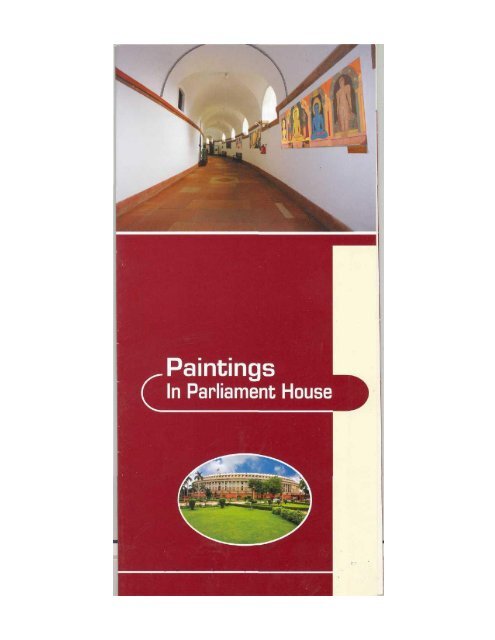
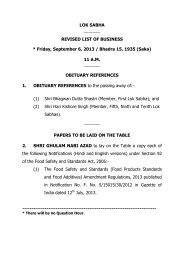
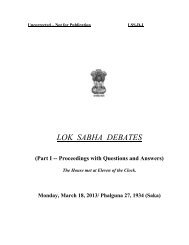

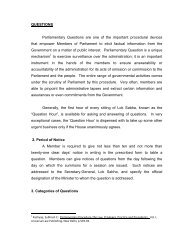
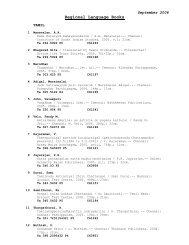

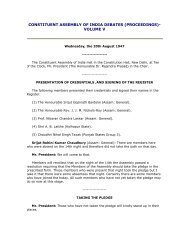
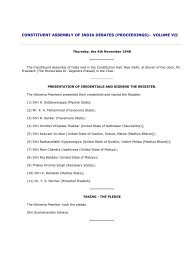
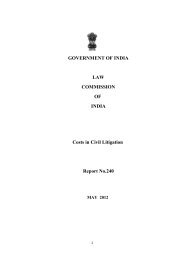
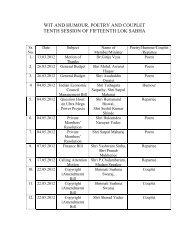
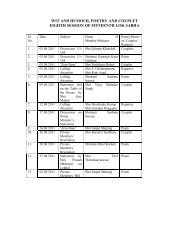

![gÉÉŌ A.]ÉŌ. xÉÉxÉÉ](https://img.yumpu.com/8015720/1/190x245/geeo-aeo-xeexee.jpg?quality=85)
